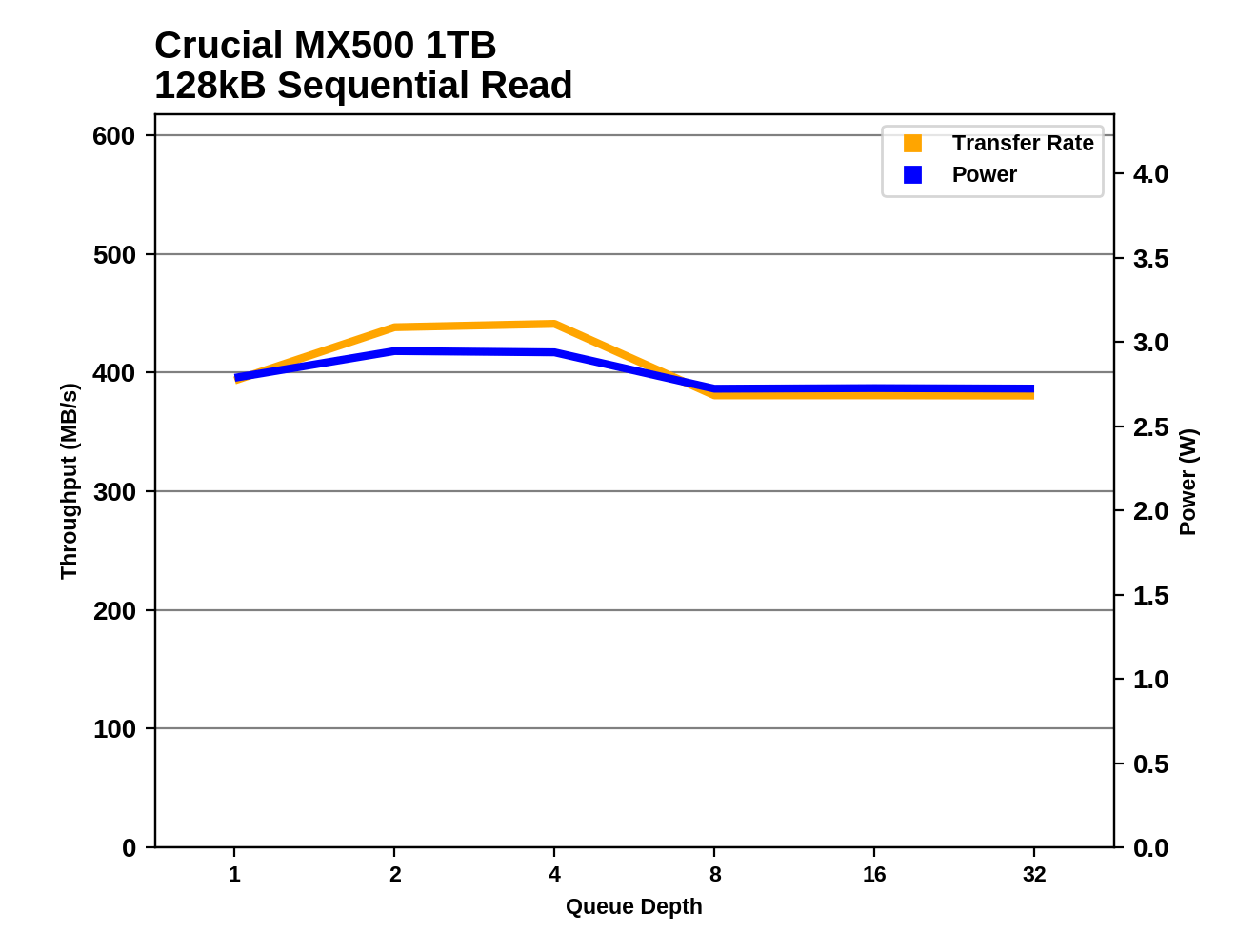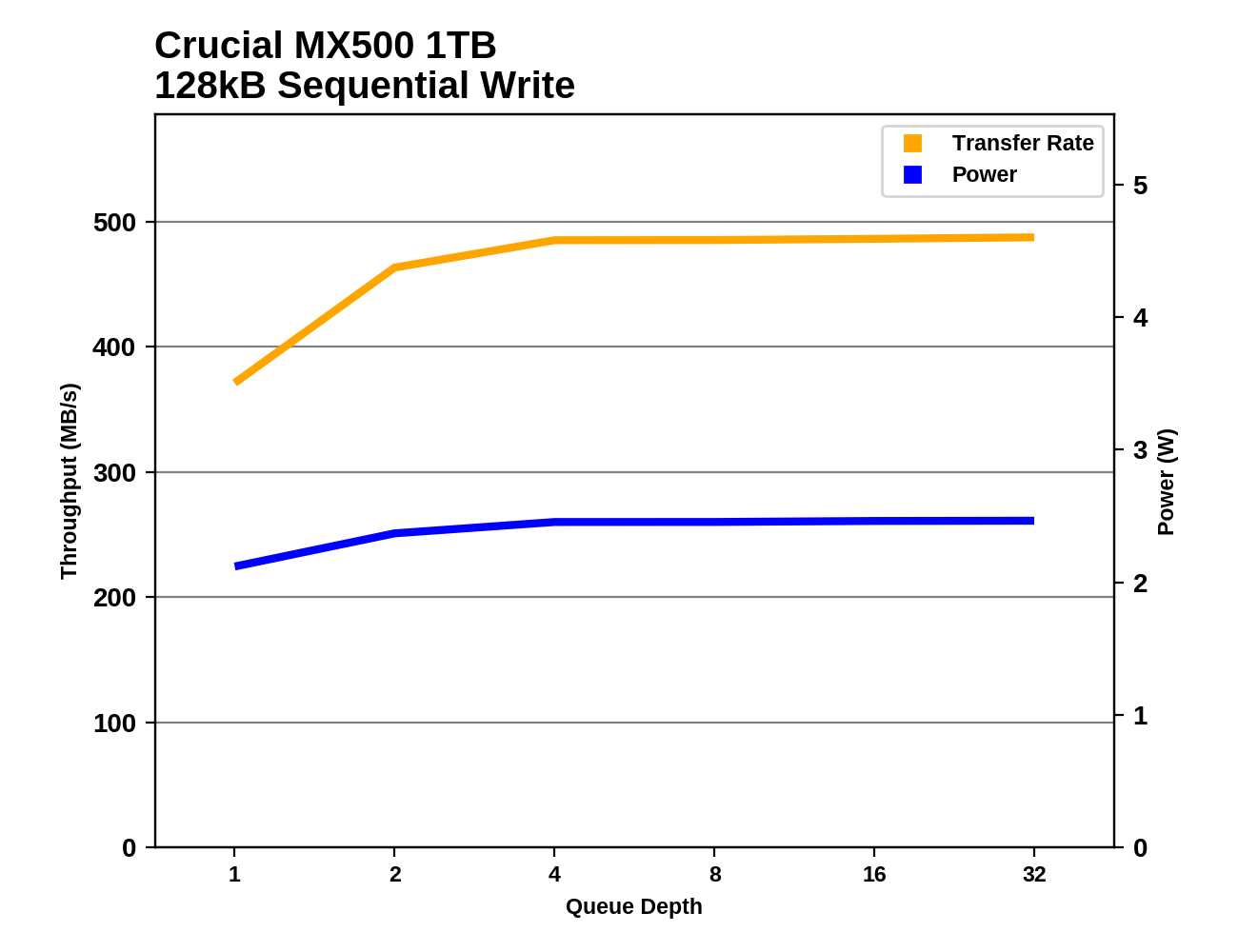The Crucial MX500 1TB SSD Review: Breaking The SATA Mold
by Billy Tallis on December 19, 2017 8:00 AM ESTSequential Read Performance
Our first test of sequential read performance uses short bursts of 128MB, issued as 128kB operations with no queuing. The test averages performance across eight bursts for a total of 1GB of data transferred from a drive containing 16GB of data. Between each burst the drive is given enough idle time to keep the overall duty cycle at 20%.

The Crucial MX500 turns in another record-setting burst performance score with its sequential read results, but by the smallest margin yet. It's about 6% faster on this test than most mainstream SATA SSDs.
Our test of sustained sequential reads uses queue depths from 1 to 32, with the performance and power scores computed as the average of QD1, QD2 and QD4. Each queue depth is tested for up to one minute or 32GB transferred, from a drive containing 64GB of data.

The sustained sequential read performance of the Crucial MX500 puts it in second place, behind the Samsung 850 PRO and 850 EVO. The MX500 does have a slight advantage over the other 64L 3D TLC drives, and improves on the MX300's performance by an impressive 100 MB/s.

The power efficiency of the Crucial MX500 during sequential reads is mediocre and clearly worse than the other 64L 3D TLC drives, including the Intel 545s. The MX500 is slightly more efficient than the Samsung 850 PRO and EVO, and scores 21% higher than the MX300.
 |
|||||||||
The Samsung 850 PRO and EVO are the only drives that continuously saturate the SATA bus from QD2 onwards with no drops in performance. The MX500's performance is reasonably steady but does drop a bit as the test wears on.
Sequential Write Performance
Our test of sequential write burst performance is structured identically to the sequential read burst performance test save for the direction of the data transfer. Each burst writes 128MB as 128kB operations issued at QD1, for a total of 1GB of data written to a drive containing 16GB of data.

For once, the burst performance of the Crucial MX500 doesn't set a record. Its QD1 sequential write speed is only second-fastest, about 3% slower than the Samsung 850 PRO.
Our test of sustained sequential writes is structured identically to our sustained sequential read test, save for the direction of the data transfers. Queue depths range from 1 to 32 and each queue depth is tested for up to one minute or 32GB, followed by up to one minute of idle time for the drive to cool off and perform garbage collection. The test is confined to a 64GB span of the drive.

The sustained sequential write speed of the MX500 is the same as the MX300, putting them in the second tier of performance behind the Samsung 850 PRO and EVO and the MLC-based Patriot Ignite.

The Crucial MX500 scores great on power efficiency during sequential writes, but not quite as well as the MX300. The OCZ VX500 with its reduced DRAM cache holds on to first place and the Toshiba TR200 (entirely DRAMless) comes in right behind the MX500. The mainstream 3D TLC drives are all much less efficient.
 |
|||||||||
Only a few drives offer a higher sustained sequential write speed than the MX500 after reaching saturation. The Samsung drives and the Patriot Ignite are faster at all queue depths and much less pwoer efficient than the MX500, while the OCZ VX500 stumbles at QD2 before saturating with slightly higher throughput and substantially lower power consumption. The MX300 is a bit faster than the MX500 at QD2 but slightly slower at higher queue depths.










90 Comments
View All Comments
Flunk - Tuesday, December 19, 2017 - link
It's a shame they don't native compile it. The Oracle Java runtime is such a security problem I just don't have it installed on anything anymore.coder111 - Tuesday, December 19, 2017 - link
What on earth are you talking about? Don't install the browser plugin- no security problem. And get JDK, not JRE. Java language or runtime environment is not a security threat in any way. Browser plugin is, but it's been obsolete for more than a decade and only used for legacy applications, and shouldn't be used at all.Wolfpup - Tuesday, December 19, 2017 - link
I still don't want it on my system...but I'm sure I've updated firmware on Crucial drives without Java installed.smilingcrow - Tuesday, December 19, 2017 - link
Just uninstall after using the software as it's not as if you need to run an SSD utility frequently.Cooe - Wednesday, December 20, 2017 - link
Tin foil hat alert :)erple2 - Thursday, December 28, 2017 - link
Wait, what? Unless you're compiling Java applications, or trying to profile a running Java application and want to tune jvm settings, there's no real need anymore for the jdk. The jre is more than sufficient for the vast majority of needs. The days of the jre java.exe being subpar to java.exe included in the jdk died in the 1.6 days.mode_13h - Tuesday, December 19, 2017 - link
Traditionally, you can use the Micron enterprise tool with many of these drives. They caution against it, but it works fine in at least some cases - probably the MX drives are a good bet.HardwareDufus - Tuesday, December 19, 2017 - link
I have an OCZ-VERTEX4.. so I was looking at reviews here on AnandTech of my device to make a comparison. However, my drive was reviewed in 2012... when they used Desktop Iometer... which shows really high numbers....How do the newer testing methods at AnandTech differ from what they did in the past. Per these 2012 charts, my Vertex4 is faster.... but I know that's not the case after 5 years of progress...
mapesdhs - Saturday, December 23, 2017 - link
I've run AS-SSD, CDM, ATTO and HDTach on drives going back to the Vertex 4 (also 3, 2E, Agility 4 and Vector). I have some M.2 results to add to the archive, but here it is atm:http://www.sgidepot.co.uk/misc/ssdtests.zip
mapesdhs - Saturday, December 23, 2017 - link
Forgot to mention, the Vertex 4 is still a good drive. Just make sure the fw is up to date. Think the latest is 1.5.